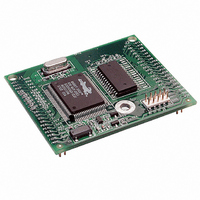20-101-0404 Rabbit Semiconductor, 20-101-0404 Datasheet - Page 13

20-101-0404
Manufacturer Part Number
20-101-0404
Description
MODULE RABBITCORE RCM2000
Manufacturer
Rabbit Semiconductor
Datasheet
1.20-101-0383.pdf
(80 pages)
Specifications of 20-101-0404
Module/board Type
MPU Core Module
Product
Microcontroller Modules
Core Processor
Rabbit 2000
Clock Speed
25.8 MHz
Interface Type
Ethernet, Serial
Flash
256 KB
Timers
5 x 8 bit, 2 x 10 bit
Operating Supply Voltage
4.75 V to 5.25 V
Board Size
48.3 mm x 58.4 mm x 14 mm
Core
RCM2000
Processor Series
RCM2000
Cpu Core
Rabbit 2000
For Use With/related Products
RCM2000
Lead Free Status / RoHS Status
Lead free / RoHS Compliant
Other names
316-1083
2.2 Run a Sample Program
Once the RCM2000 is connected as described in the preceding pages, start Dynamic C by
double-clicking on the Dynamic C icon on your desktop or in your
uses the serial port specified during installation.
If you are using a USB port to connect your computer to the RCM2000 module, choose
Options > Project Options
Communications
Find the file
open it with the
by selecting
square bouncing around in a box.
2.2.1 Troubleshooting
If Dynamic C cannot find the target system (error message
Detected."
• Check that the RCM2000 is powered correctly —
• Check both ends of the programming cable to ensure that they are firmly plugged into
• Ensure that the RCM2000 module is firmly and correctly installed in its connectors on
• Dynamic C uses the COM port specified during installation. Select a different COM
If Dynamic C appears to compile the BIOS successfully, but you then receive a communi-
cation error message when you compile and load the sample program, it is possible that
your PC cannot handle the higher program-loading baud rate. Try changing the maximum
download rate to a slower baud rate as follows.
• Locate the
If a program compiles and loads, but then loses target communication before you can
begin debugging, it is possible that your PC cannot handle the default debugging baud
rate. Try lowering the debugging baud rate as follows.
• Locate the
User’s Manual
Board should be lit when the RCM2000 is mounted on the Prototyping Board and the AC
adapter is plugged in
the PC and the
ming port on the RCM2000 with the marked (colored) edge of the programming cable
towards pin 1 of the programming header.
the Prototyping Board.
port within Dynamic C. From the
Communications
<Ctrl-Y>
unable to locate the target system, repeat the above steps until you locate the COM port
used by the programming cable.
Communications
Communications
Run
to force Dynamic C to recompile the BIOS. If Dynamic C still reports it is
PONG.C
):
Serial Options
Serial Options
File
in the
PROG
tab, then click
menu (if it is not still open), then compile and run it by pressing
, which is in the Dynamic C
. Select another COM port from the list, then click OK. Press
.
menu. Select a slower Max download baud rate.
menu. Choose a lower debug baud rate.
Run
connector, not the
menu. The
and select “Use USB to Serial Converter” under the
dialog in the Dynamic C
dialog in the Dynamic C
OK
Options
.
STDIO
DIAG
menu, select
window will open and will display a small
SAMPLES
connector, is plugged in to the program-
the red power LED on the Prototyping
Options > Project Options >
Options > Project Options >
"No Rabbit Processor
Project Options
folder. To run the program,
Start
menu. Dynamic C
, then select
F9
or
9

















